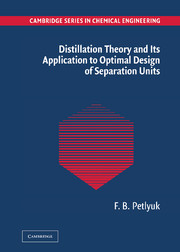Book contents
- Frontmatter
- Contents
- Preface
- Acknowledgements
- Nomenclature
- 1 Phase Equilibrium and Its Geometric Presentation
- 2 Basic Concepts of Distillation
- 3 Trajectories of Distillation in Infinite Columns Under Infinite Reflux
- 4 Trajectories of Thermodynamically Reversible Distillation
- 5 Distillation Trajectories and Conditions of Mixture Separability in Simple Infinite Columns at Finite Reflux
- 6 Distillation Trajectories in Infinite Complex Columns and Complexes
- 7 Trajectories of the Finite Columns and Their Design Calculation
- 8 Synthesis of Separation Flowsheets
- Short Glossary
- Index
- References
6 - Distillation Trajectories in Infinite Complex Columns and Complexes
Published online by Cambridge University Press: 08 August 2009
- Frontmatter
- Contents
- Preface
- Acknowledgements
- Nomenclature
- 1 Phase Equilibrium and Its Geometric Presentation
- 2 Basic Concepts of Distillation
- 3 Trajectories of Distillation in Infinite Columns Under Infinite Reflux
- 4 Trajectories of Thermodynamically Reversible Distillation
- 5 Distillation Trajectories and Conditions of Mixture Separability in Simple Infinite Columns at Finite Reflux
- 6 Distillation Trajectories in Infinite Complex Columns and Complexes
- 7 Trajectories of the Finite Columns and Their Design Calculation
- 8 Synthesis of Separation Flowsheets
- Short Glossary
- Index
- References
Summary
Introduction
This chapter extends the geometric description of the distillation process to infinite complex columns and complexes, and then on this basis to develop methods of their calculation.
Here we understand by complex columns a countercurrent cascade without branching of flows, without recycles and bypasses, which, in contrast to simple columns, contains more than two sections. The complex column is a column with several inputs and/or outputs of flows. The column of extractive distillation with two inputs of flows – feed input and entrainer input – is an example of a complex column.
We understand by distillation complex a countercurrent cascade with branching of flows, with recycles or bypasses of flows. Columns with side stripping or side rectifier and columns with completely connected thermal flows (the so-called “Petlyuk columns”) are examples of distillation complexes with branching of flows. A column of extractive distillation, together with a column of entrainer regeneration, make an example of a complex with recycle of flows. Columns of this complex work independently of each other; therefore, we do not examine it in this chapter, and the questions of its usage in separation of azeotropic mixtures and questions of determination of entrainer optimal flow rate are discussed in the following chapters.
The fundamental difference between complex columns and complexes and simple columns lies in the availability of intermediate sections (besides the top and the bottom ones). The intermediate sections exchange vapor and liquid flows with other sections or with the decanter.
- Type
- Chapter
- Information
- Publisher: Cambridge University PressPrint publication year: 2004



